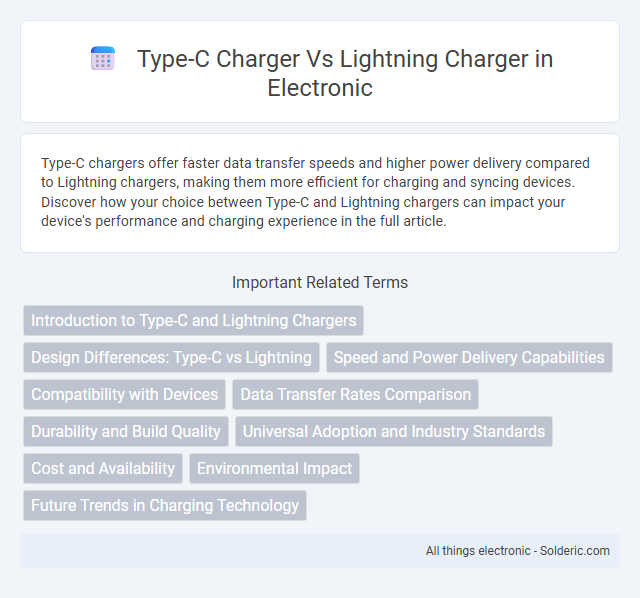Type-C chargers offer faster data transfer speeds and higher power delivery compared to Lightning chargers, making them more efficient for charging and syncing devices. Discover how your choice between Type-C and Lightning chargers can impact your device's performance and charging experience in the full article.
Comparison Table
| Feature | Type-C Charger | Lightning Charger |
|---|---|---|
| Connector Type | USB Type-C | Apple Lightning |
| Compatibility | Universal (Android, laptops, accessories) | Apple devices (iPhone, iPad, iPod) |
| Charging Speed | Up to 100W (Power Delivery) | Up to 20W (Apple Fast Charge) |
| Data Transfer Rate | Up to 10 Gbps (USB 3.1 Gen 2) | Up to 480 Mbps (USB 2.0) |
| Reversibility | Reversible connector | Reversible connector |
| Durability | High (Robust, widely used) | Moderate (Smaller pins, fragile) |
| Adoption | Industry standard, growing universal use | Exclusive to Apple ecosystem |
Introduction to Type-C and Lightning Chargers
Type-C chargers feature a reversible connector with fast data transfer and charging capabilities, widely adopted across modern smartphones, tablets, and laptops due to their universal compatibility and USB Power Delivery support. Lightning chargers, proprietary to Apple devices, provide a compact design optimized for iPhones, iPads, and iPods, ensuring efficient power delivery and device-specific communication protocols. The transition towards Type-C reflects a global standardization effort, while Lightning remains integral to Apple's ecosystem.
Design Differences: Type-C vs Lightning
Type-C chargers feature a reversible, oval-shaped connector with 24 pins enabling faster data transfer and higher power delivery, while Lightning chargers have an 8-pin proprietary design exclusive to Apple devices. The Type-C design supports universal compatibility across numerous brands and devices, whereas Lightning is limited to Apple products but offers a slim, symmetrical shape that fits neatly into iPhones and iPads. Choosing a Type-C charger enhances your device's charging speed and cross-platform usability compared to the Apple-centric Lightning design.
Speed and Power Delivery Capabilities
Type-C chargers support higher power delivery standards, often up to 100W, enabling faster charging for a wide range of devices, including laptops and smartphones. Lightning chargers typically offer lower power output, around 12-18W, limiting charging speed mainly to iPhones and older Apple accessories. Your choice impacts charging efficiency and device compatibility, with Type-C providing superior speed and versatile power delivery for modern electronics.
Compatibility with Devices
Type-C chargers offer broad compatibility across numerous devices, including Android smartphones, tablets, laptops, and newer Apple iPads, supporting fast charging and data transfer. Lightning chargers are specifically designed for Apple devices such as iPhones, older iPads, and AirPods, limiting their use to the Apple ecosystem. Choosing between Type-C and Lightning chargers depends on device compatibility needs and whether cross-platform charging versatility or exclusive Apple device support is preferred.
Data Transfer Rates Comparison
Type-C chargers offer significantly faster data transfer rates, supporting up to 10 Gbps with USB 3.1 and even 40 Gbps with Thunderbolt 3 and 4 technologies. Lightning chargers, primarily used by Apple devices, provide data transfer speeds around 480 Mbps with USB 2.0 standards. For your data-heavy tasks and faster synchronization, Type-C chargers present a more efficient option.
Durability and Build Quality
Type-C chargers typically offer enhanced durability with reinforced connectors and thicker cables designed to withstand frequent bending and unplugging, making them more resilient over time compared to Lightning chargers. Apple's Lightning cables have improved build quality but often face criticism for fraying near the ends due to thinner insulation and tighter connection tolerances. Choosing a Type-C charger can provide better longevity and robust performance for your devices, reducing the need for frequent replacements.
Universal Adoption and Industry Standards
Type-C chargers have gained universal adoption across various devices including smartphones, laptops, and tablets due to their compatibility with industry standards like USB Power Delivery (USB-PD), enabling faster and more efficient charging. Lightning chargers remain exclusive to Apple products, limiting interoperability and forcing users to carry multiple cables for different devices. Choosing a Type-C charger can future-proof your charging needs with widespread support and standardized protocols.
Cost and Availability
Type-C chargers tend to be more cost-effective due to widespread adoption across various devices, reducing manufacturing expenses and increasing availability. Lightning chargers, primarily used by Apple products, often come at a higher price point with limited availability outside authorized retailers. Choosing a Type-C charger can save you money and offer greater convenience when sourcing replacement cables.
Environmental Impact
Type-C chargers promote environmental sustainability through universal compatibility and faster charging efficiency, reducing electronic waste and energy consumption. Lightning chargers, exclusive to Apple devices, contribute to higher e-waste volumes due to limited interoperability and frequent cable replacements. Choosing a Type-C charger for your devices can significantly lower your environmental footprint by minimizing discarded chargers and improving energy use.
Future Trends in Charging Technology
Type-C chargers are becoming the industry standard due to their faster data transfer rates and higher power delivery capabilities, supporting up to 100W with USB Power Delivery (USB-PD) protocols. Lightning chargers, primarily used by Apple devices, face gradual obsolescence as Apple adopts USB-C ports in newer models, aligning with global regulatory trends favoring universal charging standards. Future charging technology trends emphasize faster wireless charging, increased power efficiency, and wider adoption of universal USB-C connectors for both Android and Apple ecosystems.
Type-C charger vs Lightning charger Infographic

 solderic.com
solderic.com